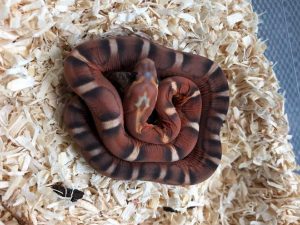Corn Snake
Pantherophis guttatus

Native to Southwestern and Central USA, these docile snakes are perfect for beginners due to their low maintenance requirements and ease of handling.
Latin Name: Pantherophis guttatus
Difficulty Level: Beginner
Temperament: Docile
Life Span: 15 – 20 Years
Size: 3 Feet – 5 Feet
Habitat: South West / Central USA – Grassland, Forest.
Diet: Feed Adults 1 Large / Extra Large Mouse every 7 – 10 Days.
Hatchlings can be fed a small pinky mouse every 5 – 7 days.
Be sure to never feed live food, as it can harm the Snake whilst trying to defend itself.
Avoid feeding them anything that isn’t a delicious rodent.
Supplements: None
Hours of Activity: Nocturnal – Corn Snakes are most active at nighttime.
Handling: Do not startle your Snake but begin by touching its back to let it know you’re there. Then carefully but confidently lift the Snake up, supporting its body weight from the mid-section.
Do not grab.
Do not handle your snake for up to 2 days after it has eaten or when it has just shed its skin.
Temperature:
20°C – 24°C Ambient Day time Temperature.
28°C – 30°C Basking Area.
20°C – 22°C Ambient Night time Temperature.
Humidity: 35% – 60%
Vivarium Size: 48″ x 24″ x 24″ (Minimum) However, this does depend on the size of the snake.
Substrate Type: Wood Chips, Bark, Tropical Soil Mix, Coconut Fibres, Aspen.
These Snakes like to burrow, so provide a layer of loose substrate on top for this purpose.
Equipment Necessary: Vivarium, Basking Bulb at one end of the enclosure, Thermometers, Thermostat, Places to hide.
Cleaning Instructions: Spot clean any muck or wet substrate daily. Deep clean the vivarium once per month.
Healthy Behaviour: Clear Eyes, Bright Colouration, attacks food with vigour, moves around enclosure and explores often, regular tongue flickering to taste the air.
Sick Behaviour: Lethargic, Hiding a lot, Not eating, Incomplete shedding of skin.
Be sure to have one end of the Vivarium for heating and basking, and the other end for cooling.
Waste should be solid brown with a white cap of urate. There should also be a small amount of liquid urine.
You should never house more than 1 Corn Snake per enclosure.
If the Corn Snake is stressed and defensive, it may vibrate its tail like a Rattlesnake. This is a warning to back away and leave the snake alone.
Provide fresh water in a bowl and change regularly, especially if the water becomes fouled by waste.
Common Problems:
Incomplete Shedding – Usually due to lack of adequate humidity. The Snake can be bathed in lukewarm water for 15 – 20 minutes to help finish shedding.
Mites – Be sure to check over your new Snake before you bring it home. Mites appear as dark specks on the Snake’s skin and cause irritation. Seek veterinary advice.
Respiratory Infections – Caused by improper temperature regulation in the enclosure. If you notice bubbles around the mouth or nose, seek immediate veterinary advice.
Stomatitis – Caused by bacteria, this makes the snake produce excessive drool and have a sore mouth. Change the substrate and seek veterinary assistance.
